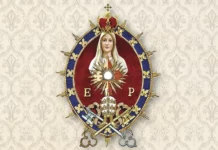If we could sum up in one word what moved the souls who gathered in throngs around Jesus, it would be “admiration”. Indeed, after the narration of the countless portents – miracles of healing, resurrection, exorcisms, etc. – the Evangelists are insistent in revealing the general state of wonder: “And all the crowd… were greatly amazed”; “they were all marvelling at everything He did,” or they “wondered at the gracious words which proceeded out of His mouth” (cf. Mk 9:15; Lk 9:43; Lk 4:22). Now, what is the reason for all this enthusiasm?
Admiration is born when the soul wishes to recognize the cause from its effects. It is the doorway for every metaphysical movement, that is, the first look of the intelligence, as even the origin of the word indicates: “to regard with wonder” (ad + mirari). If in fact a beautiful panorama so enchants us, what can we say about the divine gaze of the Redeemer? However, as we know, many – like Judas – have refused this most sacred gaze, preferring blindness of soul to the rays of the Sun of Justice.
Our Lady, in contrast, was the archetype of admiring souls. At the Annunciation, She declared herself “the handmaid of the Lord” (Lk 1:38); because the Saviour regarded her humility, She magnified God at the Visitation (cf. Lk 1:47-48) and at the Birth of Jesus She was able to finally glorify, together with the Angels, the very cause of admiration. Among these three motions of Mary’s soul – that is, servitude, exultation and glorification of God – the first is perhaps the most crucial. In fact, in her attitude of slavery is found the seed of her unmatched obedience, her love for her Son and, finally, her unconditional surrender to the designs of Providence, that is, to what the Trinity had always provided (“foreseen”) for her.
The history of the Saints, and in particular of the founders, is nothing other than the mirror of this initial act of admiration and consequent attitude of slavery. In fact, it was under this influence that Maurus obeyed his spiritual father Benedict to save Placidus. It was by contemplating the wounds of the Poverello that a cohort of souls united themselves with Francis, the “other crucified Christ”. It was as if in a glance that Don Bosco admired Dominic Savio’s innocence, affectionately calling him “good cloth” (before his mother who was a seamstress). And the young man’s response sprang forth in a flash: “I am a cloth; may you then be the tailor to prepare a beautiful garment for the Lord!”
After such a troubled year as 2020, our spirit certainly yearns for a very different new year. What will it be like? We do not know. But it is enough for us to contemplate the admirable example of Mary and that of the constellation of blessed souls to see that a genuine change in society can only begin with individual conversion. It is urgent, then, to seek a new “gaze”, which means turning our back on selfishness and so many other vices which prevent us from admiring. And so, at every moment, we will be able to rightly pray to the Most High: “Behold Thy slave, be it done to me according to Thy will!” ◊




